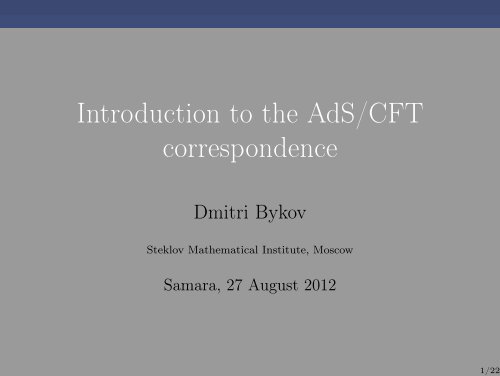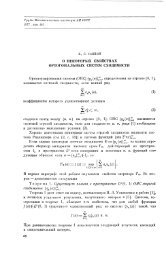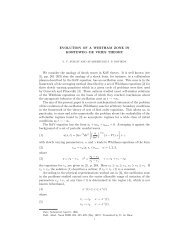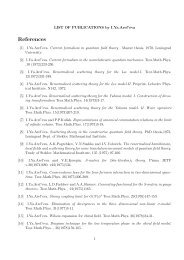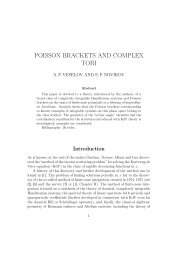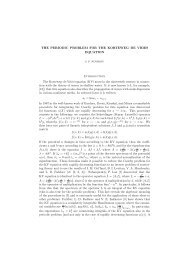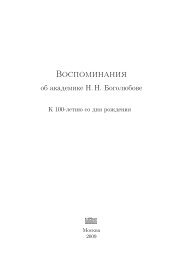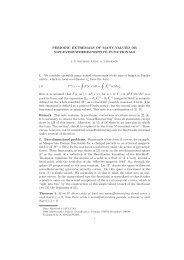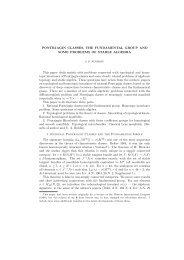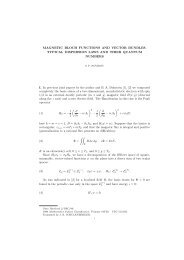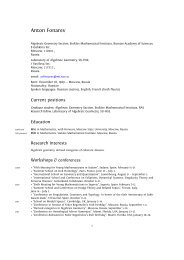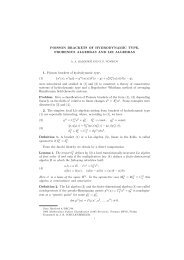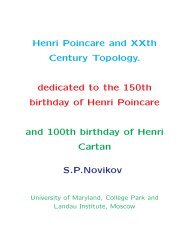Introduction to the AdS/CFT correspondence
Introduction to the AdS/CFT correspondence
Introduction to the AdS/CFT correspondence
You also want an ePaper? Increase the reach of your titles
YUMPU automatically turns print PDFs into web optimized ePapers that Google loves.
1/22<br />
<strong>Introduction</strong> <strong>to</strong> <strong>the</strong> <strong>AdS</strong>/<strong>CFT</strong><br />
<strong>correspondence</strong><br />
Dmitri Bykov<br />
Steklov Ma<strong>the</strong>matical Institute, Moscow<br />
Samara, 27 August 2012
2/22<br />
The main concept<br />
<br />
<br />
<br />
Quantum field <strong>the</strong>ory in R D can be described<br />
by gravity in <strong>AdS</strong> D 1 Maldacena, 1997<br />
Especially strong quantitative evidence in <strong>the</strong><br />
conformal case, however we will also describe<br />
<strong>the</strong> non-conformal setup<br />
The extra dimension has <strong>the</strong> interpretation of<br />
RG-scale in QFT
2/22<br />
The main concept<br />
<br />
<br />
<br />
Quantum field <strong>the</strong>ory in R D can be described<br />
by gravity in <strong>AdS</strong> D 1 Maldacena, 1997<br />
Especially strong quantitative evidence in <strong>the</strong><br />
conformal case, however we will also describe<br />
<strong>the</strong> non-conformal setup<br />
The extra dimension has <strong>the</strong> interpretation of<br />
RG-scale in QFT
2/22<br />
The main concept<br />
<br />
<br />
<br />
Quantum field <strong>the</strong>ory in R D can be described<br />
by gravity in <strong>AdS</strong> D 1 Maldacena, 1997<br />
Especially strong quantitative evidence in <strong>the</strong><br />
conformal case, however we will also describe<br />
<strong>the</strong> non-conformal setup<br />
The extra dimension has <strong>the</strong> interpretation of<br />
RG-scale in QFT
2/22<br />
The main concept<br />
<br />
<br />
<br />
Quantum field <strong>the</strong>ory in R D can be described<br />
by gravity in <strong>AdS</strong> D 1 Maldacena, 1997<br />
Especially strong quantitative evidence in <strong>the</strong><br />
conformal case, however we will also describe<br />
<strong>the</strong> non-conformal setup<br />
The extra dimension has <strong>the</strong> interpretation of<br />
RG-scale in QFT
3/22<br />
The <strong>AdS</strong> space<br />
<br />
<br />
<br />
<br />
A non-compact manifold with constant<br />
negative curvature and Lorentzian signature<br />
Can be viewed as a quotient space (coset)<br />
<strong>AdS</strong> D 1 SOp2,Dq<br />
SOp1,Dq<br />
For <strong>the</strong> moment let us set D 2 and<br />
consider <strong>AdS</strong> 3<br />
The simplest model: a hyperboloid<br />
¡Y 2 ¡1 ¡ Y 2<br />
0 Y 2<br />
1 Y 2<br />
2 ¡R2 inside R 2,2 :<br />
ds 2 ¡dY¡1 2 ¡ dY 0 2 dY 1 2 dY 2<br />
2
3/22<br />
The <strong>AdS</strong> space<br />
<br />
<br />
<br />
<br />
A non-compact manifold with constant<br />
negative curvature and Lorentzian signature<br />
Can be viewed as a quotient space (coset)<br />
<strong>AdS</strong> D 1 SOp2,Dq<br />
SOp1,Dq<br />
For <strong>the</strong> moment let us set D 2 and<br />
consider <strong>AdS</strong> 3<br />
The simplest model: a hyperboloid<br />
¡Y 2 ¡1 ¡ Y 2<br />
0 Y 2<br />
1 Y 2<br />
2 ¡R2 inside R 2,2 :<br />
ds 2 ¡dY¡1 2 ¡ dY 0 2 dY 1 2 dY 2<br />
2
3/22<br />
The <strong>AdS</strong> space<br />
<br />
<br />
<br />
<br />
A non-compact manifold with constant<br />
negative curvature and Lorentzian signature<br />
Can be viewed as a quotient space (coset)<br />
<strong>AdS</strong> D 1 SOp2,Dq<br />
SOp1,Dq<br />
For <strong>the</strong> moment let us set D 2 and<br />
consider <strong>AdS</strong> 3<br />
The simplest model: a hyperboloid<br />
¡Y 2 ¡1 ¡ Y 2<br />
0 Y 2<br />
1 Y 2<br />
2 ¡R2 inside R 2,2 :<br />
ds 2 ¡dY¡1 2 ¡ dY 0 2 dY 1 2 dY 2<br />
2
3/22<br />
The <strong>AdS</strong> space<br />
<br />
<br />
<br />
<br />
A non-compact manifold with constant<br />
negative curvature and Lorentzian signature<br />
Can be viewed as a quotient space (coset)<br />
<strong>AdS</strong> D 1 SOp2,Dq<br />
SOp1,Dq<br />
For <strong>the</strong> moment let us set D 2 and<br />
consider <strong>AdS</strong> 3<br />
The simplest model: a hyperboloid<br />
¡Y 2 ¡1 ¡ Y 2<br />
0 Y 2<br />
1 Y 2<br />
2 ¡R2 inside R 2,2 :<br />
ds 2 ¡dY¡1 2 ¡ dY 0 2 dY 1 2 dY 2<br />
2
3/22<br />
The <strong>AdS</strong> space<br />
<br />
<br />
<br />
<br />
A non-compact manifold with constant<br />
negative curvature and Lorentzian signature<br />
Can be viewed as a quotient space (coset)<br />
<strong>AdS</strong> D 1 SOp2,Dq<br />
SOp1,Dq<br />
For <strong>the</strong> moment let us set D 2 and<br />
consider <strong>AdS</strong> 3<br />
The simplest model: a hyperboloid<br />
¡Y 2 ¡1 ¡ Y 2<br />
0 Y 2<br />
1 Y 2<br />
2 ¡R2 inside R 2,2 :<br />
ds 2 ¡dY¡1 2 ¡ dY 0 2 dY 1 2 dY 2<br />
2
4/22<br />
The <strong>AdS</strong> space. 2.<br />
<br />
The global coordinates<br />
Y ¡1 cosh prq cos ptq, Y 0 cosh prq sin ptq,<br />
Y 1 sinh prq cos pφq, Y 2 sinh prq sin pφq<br />
ds 2 ¡ cosh prq 2 dt 2 dr 2 sinh prq 2 dφ 2 ,<br />
r P r0, 8q, t P p¡8, 8q, φ P r0, 2πq<br />
A conformal rescaling ds 2 cosh prq 2 d˜s 2<br />
and change of coordinates<br />
w 2 arctan pe r q ¡ π produces a metric<br />
2<br />
d˜s 2 ¡dt 2 dw 2 sin pwq 2 dφ 2 where<br />
w P r0, π 2 s ñ Disc
4/22<br />
The <strong>AdS</strong> space. 2.<br />
<br />
The global coordinates<br />
Y ¡1 cosh prq cos ptq, Y 0 cosh prq sin ptq,<br />
Y 1 sinh prq cos pφq, Y 2 sinh prq sin pφq<br />
ds 2 ¡ cosh prq 2 dt 2 dr 2 sinh prq 2 dφ 2 ,<br />
r P r0, 8q, t P p¡8, 8q, φ P r0, 2πq<br />
A conformal rescaling ds 2 cosh prq 2 d˜s 2<br />
and change of coordinates<br />
w 2 arctan pe r q ¡ π produces a metric<br />
2<br />
d˜s 2 ¡dt 2 dw 2 sin pwq 2 dφ 2 where<br />
w P r0, π 2 s ñ Disc
4/22<br />
The <strong>AdS</strong> space. 2.<br />
<br />
The global coordinates<br />
Y ¡1 cosh prq cos ptq, Y 0 cosh prq sin ptq,<br />
Y 1 sinh prq cos pφq, Y 2 sinh prq sin pφq<br />
ds 2 ¡ cosh prq 2 dt 2 dr 2 sinh prq 2 dφ 2 ,<br />
r P r0, 8q, t P p¡8, 8q, φ P r0, 2πq<br />
A conformal rescaling ds 2 cosh prq 2 d˜s 2<br />
and change of coordinates<br />
w 2 arctan pe r q ¡ π produces a metric<br />
2<br />
d˜s 2 ¡dt 2 dw 2 sin pwq 2 dφ 2 where<br />
w P r0, π 2 s ñ Disc
5/22<br />
The <strong>AdS</strong> space. 3.<br />
<br />
Hence we arrive at <strong>the</strong> Penrose diagram of<br />
<strong>AdS</strong> — a cylinder:
5/22<br />
The <strong>AdS</strong> space. 3.<br />
<br />
Hence we arrive at <strong>the</strong> Penrose diagram of<br />
<strong>AdS</strong> — a cylinder:
6/22<br />
The <strong>AdS</strong> space. 4.<br />
<br />
<br />
<strong>AdS</strong> has a boundary, i.e. a hypersurface<br />
reflecting light rays: r 8<br />
Massive geodesics are confined inside <strong>AdS</strong>
6/22<br />
The <strong>AdS</strong> space. 4.<br />
<br />
<br />
<strong>AdS</strong> has a boundary, i.e. a hypersurface<br />
reflecting light rays: r 8<br />
Massive geodesics are confined inside <strong>AdS</strong>
6/22<br />
The <strong>AdS</strong> space. 4.<br />
<br />
<br />
<strong>AdS</strong> has a boundary, i.e. a hypersurface<br />
reflecting light rays: r 8<br />
Massive geodesics are confined inside <strong>AdS</strong>
7/22<br />
Partition functions<br />
<br />
<br />
The <strong>correspondence</strong> can be made more precise<br />
Gubser, Klebanov, Polyakov; Witten, 1998<br />
To every field ϕ in <strong>the</strong> bulk of <strong>AdS</strong> <strong>the</strong>re<br />
corresponds a local opera<strong>to</strong>r Opxq on <strong>the</strong><br />
boundary<br />
For example, g µν ô T µν , A µ ô J µ<br />
<br />
<br />
Moreover, xe i ³ d 4 x φ 0 pxq Opxq y Z bulk pφ 0 q<br />
— <strong>the</strong> partition function of <strong>the</strong> bulk <strong>the</strong>ory<br />
with <strong>the</strong> condition φ Ñ φ 0 at <strong>the</strong> boundary<br />
i<br />
»<br />
d 4 x A µ B pxq J µ pxq is gauge-invariant!
7/22<br />
Partition functions<br />
<br />
<br />
The <strong>correspondence</strong> can be made more precise<br />
Gubser, Klebanov, Polyakov; Witten, 1998<br />
To every field ϕ in <strong>the</strong> bulk of <strong>AdS</strong> <strong>the</strong>re<br />
corresponds a local opera<strong>to</strong>r Opxq on <strong>the</strong><br />
boundary<br />
For example, g µν ô T µν , A µ ô J µ<br />
<br />
<br />
Moreover, xe i ³ d 4 x φ 0 pxq Opxq y Z bulk pφ 0 q<br />
— <strong>the</strong> partition function of <strong>the</strong> bulk <strong>the</strong>ory<br />
with <strong>the</strong> condition φ Ñ φ 0 at <strong>the</strong> boundary<br />
i<br />
»<br />
d 4 x A µ B pxq J µ pxq is gauge-invariant!
7/22<br />
Partition functions<br />
<br />
<br />
The <strong>correspondence</strong> can be made more precise<br />
Gubser, Klebanov, Polyakov; Witten, 1998<br />
To every field ϕ in <strong>the</strong> bulk of <strong>AdS</strong> <strong>the</strong>re<br />
corresponds a local opera<strong>to</strong>r Opxq on <strong>the</strong><br />
boundary<br />
For example, g µν ô T µν , A µ ô J µ<br />
<br />
<br />
Moreover, xe i ³ d 4 x φ 0 pxq Opxq y Z bulk pφ 0 q<br />
— <strong>the</strong> partition function of <strong>the</strong> bulk <strong>the</strong>ory<br />
with <strong>the</strong> condition φ Ñ φ 0 at <strong>the</strong> boundary<br />
i<br />
»<br />
d 4 x A µ B pxq J µ pxq is gauge-invariant!
7/22<br />
Partition functions<br />
<br />
<br />
The <strong>correspondence</strong> can be made more precise<br />
Gubser, Klebanov, Polyakov; Witten, 1998<br />
To every field ϕ in <strong>the</strong> bulk of <strong>AdS</strong> <strong>the</strong>re<br />
corresponds a local opera<strong>to</strong>r Opxq on <strong>the</strong><br />
boundary<br />
For example, g µν ô T µν , A µ ô J µ<br />
<br />
<br />
Moreover, xe i ³ d 4 x φ 0 pxq Opxq y Z bulk pφ 0 q<br />
— <strong>the</strong> partition function of <strong>the</strong> bulk <strong>the</strong>ory<br />
with <strong>the</strong> condition φ Ñ φ 0 at <strong>the</strong> boundary<br />
i<br />
»<br />
d 4 x A µ B pxq J µ pxq is gauge-invariant!
7/22<br />
Partition functions<br />
<br />
<br />
The <strong>correspondence</strong> can be made more precise<br />
Gubser, Klebanov, Polyakov; Witten, 1998<br />
To every field ϕ in <strong>the</strong> bulk of <strong>AdS</strong> <strong>the</strong>re<br />
corresponds a local opera<strong>to</strong>r Opxq on <strong>the</strong><br />
boundary<br />
For example, g µν ô T µν , A µ ô J µ<br />
<br />
<br />
Moreover, xe i ³ d 4 x φ 0 pxq Opxq y Z bulk pφ 0 q<br />
— <strong>the</strong> partition function of <strong>the</strong> bulk <strong>the</strong>ory<br />
with <strong>the</strong> condition φ Ñ φ 0 at <strong>the</strong> boundary<br />
i<br />
»<br />
d 4 x A µ B pxq J µ pxq is gauge-invariant!
7/22<br />
Partition functions<br />
<br />
<br />
The <strong>correspondence</strong> can be made more precise<br />
Gubser, Klebanov, Polyakov; Witten, 1998<br />
To every field ϕ in <strong>the</strong> bulk of <strong>AdS</strong> <strong>the</strong>re<br />
corresponds a local opera<strong>to</strong>r Opxq on <strong>the</strong><br />
boundary<br />
For example, g µν ô T µν , A µ ô J µ<br />
<br />
<br />
Moreover, xe i ³ d 4 x φ 0 pxq Opxq y Z bulk pφ 0 q<br />
— <strong>the</strong> partition function of <strong>the</strong> bulk <strong>the</strong>ory<br />
with <strong>the</strong> condition φ Ñ φ 0 at <strong>the</strong> boundary<br />
i<br />
»<br />
d 4 x A µ B pxq J µ pxq is gauge-invariant!
Partition functions. 2.<br />
<br />
<br />
Imagine a scalar field ϕ in <strong>the</strong> bulk of <strong>AdS</strong><br />
with <strong>the</strong> action<br />
S <br />
»<br />
d 5 y ? ¡g p∇ϕq 2<br />
m 2 ϕ 2¨ obeying<br />
a wave equation ¡△ϕ m 2 ϕ 0, where<br />
△ ? 1<br />
¡g<br />
B µ p ? ¡g g µν B ν ¤q is <strong>the</strong> Laplacian.<br />
We want <strong>to</strong> solve it with a prescribed<br />
boundary value ϕ| boundary<br />
ϕ 0<br />
8/22
Partition functions. 2.<br />
<br />
<br />
Imagine a scalar field ϕ in <strong>the</strong> bulk of <strong>AdS</strong><br />
with <strong>the</strong> action<br />
S <br />
»<br />
d 5 y ? ¡g p∇ϕq 2<br />
m 2 ϕ 2¨ obeying<br />
a wave equation ¡△ϕ m 2 ϕ 0, where<br />
△ ? 1<br />
¡g<br />
B µ p ? ¡g g µν B ν ¤q is <strong>the</strong> Laplacian.<br />
We want <strong>to</strong> solve it with a prescribed<br />
boundary value ϕ| boundary<br />
ϕ 0<br />
8/22
Partition functions. 2.<br />
<br />
<br />
Imagine a scalar field ϕ in <strong>the</strong> bulk of <strong>AdS</strong><br />
with <strong>the</strong> action<br />
S <br />
»<br />
d 5 y ? ¡g p∇ϕq 2<br />
m 2 ϕ 2¨ obeying<br />
a wave equation ¡△ϕ m 2 ϕ 0, where<br />
△ ? 1<br />
¡g<br />
B µ p ? ¡g g µν B ν ¤q is <strong>the</strong> Laplacian.<br />
We want <strong>to</strong> solve it with a prescribed<br />
boundary value ϕ| boundary<br />
ϕ 0<br />
8/22
9/22<br />
Partition functions. 3.<br />
<br />
<br />
Use Poincare coordinates:<br />
ds 2 ¡dt2 d⃗x 2 d¡1 dz2<br />
z 2<br />
. The boundary<br />
is at z 0. The equation takes <strong>the</strong> form<br />
(after <strong>the</strong> ansatz ϕ e i k¤x f pzq)<br />
f 11 1 ¡ d<br />
z f 1 ¡ pk 2 pmRq 2<br />
q f 0<br />
z 2<br />
What kind of boundary conditions can one<br />
impose?
9/22<br />
Partition functions. 3.<br />
<br />
<br />
Use Poincare coordinates:<br />
ds 2 ¡dt2 d⃗x 2 d¡1 dz2<br />
z 2<br />
. The boundary<br />
is at z 0. The equation takes <strong>the</strong> form<br />
(after <strong>the</strong> ansatz ϕ e i k¤x f pzq)<br />
f 11 1 ¡ d<br />
z f 1 ¡ pk 2 pmRq 2<br />
q f 0<br />
z 2<br />
What kind of boundary conditions can one<br />
impose?
9/22<br />
Partition functions. 3.<br />
<br />
<br />
Use Poincare coordinates:<br />
ds 2 ¡dt2 d⃗x 2 d¡1 dz2<br />
z 2<br />
. The boundary<br />
is at z 0. The equation takes <strong>the</strong> form<br />
(after <strong>the</strong> ansatz ϕ e i k¤x f pzq)<br />
f 11 1 ¡ d<br />
z f 1 ¡ pk 2 pmRq 2<br />
q f 0<br />
z 2<br />
What kind of boundary conditions can one<br />
impose?
10/22<br />
Partition functions. 4.<br />
<br />
<br />
In <strong>the</strong> limit z Ñ 0 <strong>the</strong> equation becomes<br />
homogeneous in z:<br />
z Ñ 0 : f 11 1 ¡ d<br />
z<br />
f 1 ¡ pmRq2 f 0.<br />
z 2<br />
Therefore <strong>the</strong> solution is a power function<br />
f z ∆<br />
Plugging <strong>the</strong> ansatz in<strong>to</strong> <strong>the</strong> equation and<br />
solving for ∆, one obtains<br />
dd 2<br />
Ƭ d 2<br />
¨<br />
4<br />
pmRq 2 .
10/22<br />
Partition functions. 4.<br />
<br />
<br />
In <strong>the</strong> limit z Ñ 0 <strong>the</strong> equation becomes<br />
homogeneous in z:<br />
z Ñ 0 : f 11 1 ¡ d<br />
z<br />
f 1 ¡ pmRq2 f 0.<br />
z 2<br />
Therefore <strong>the</strong> solution is a power function<br />
f z ∆<br />
Plugging <strong>the</strong> ansatz in<strong>to</strong> <strong>the</strong> equation and<br />
solving for ∆, one obtains<br />
dd 2<br />
Ƭ d 2<br />
¨<br />
4<br />
pmRq 2 .
10/22<br />
Partition functions. 4.<br />
<br />
<br />
In <strong>the</strong> limit z Ñ 0 <strong>the</strong> equation becomes<br />
homogeneous in z:<br />
z Ñ 0 : f 11 1 ¡ d<br />
z<br />
f 1 ¡ pmRq2 f 0.<br />
z 2<br />
Therefore <strong>the</strong> solution is a power function<br />
f z ∆<br />
Plugging <strong>the</strong> ansatz in<strong>to</strong> <strong>the</strong> equation and<br />
solving for ∆, one obtains<br />
dd 2<br />
Ƭ d 2<br />
¨<br />
4<br />
pmRq 2 .
Partition functions. 5.<br />
<br />
<br />
<br />
Therefore we impose <strong>the</strong> condition<br />
ϕpx, zq| zÑ0<br />
Ñ z ∆¡ ϕ 0 pxq<br />
To solve <strong>the</strong> equation with this b.c. one needs<br />
<strong>to</strong> find a function Kp⃗x, ⃗y, zq — <strong>the</strong><br />
boundary-<strong>to</strong>-boundary propaga<strong>to</strong>r — with <strong>the</strong><br />
property Kp⃗x, ⃗y, zq| zÑ0<br />
Ñ z ∆¡ δp⃗x ¡ ⃗yq .<br />
Then <strong>the</strong> desired solution may be written as<br />
ϕp⃗x, zq <br />
»<br />
d 4 y Kp⃗x, ⃗y, zq ϕ 0 pyq<br />
Check that this function is<br />
z ¨∆<br />
K <br />
z 2 p⃗x ¡ ⃗yq 2<br />
11/22
Partition functions. 5.<br />
<br />
<br />
<br />
Therefore we impose <strong>the</strong> condition<br />
ϕpx, zq| zÑ0<br />
Ñ z ∆¡ ϕ 0 pxq<br />
To solve <strong>the</strong> equation with this b.c. one needs<br />
<strong>to</strong> find a function Kp⃗x, ⃗y, zq — <strong>the</strong><br />
boundary-<strong>to</strong>-boundary propaga<strong>to</strong>r — with <strong>the</strong><br />
property Kp⃗x, ⃗y, zq| zÑ0<br />
Ñ z ∆¡ δp⃗x ¡ ⃗yq .<br />
Then <strong>the</strong> desired solution may be written as<br />
ϕp⃗x, zq <br />
»<br />
d 4 y Kp⃗x, ⃗y, zq ϕ 0 pyq<br />
Check that this function is<br />
z ¨∆<br />
K <br />
z 2 p⃗x ¡ ⃗yq 2<br />
11/22
Partition functions. 5.<br />
<br />
<br />
<br />
Therefore we impose <strong>the</strong> condition<br />
ϕpx, zq| zÑ0<br />
Ñ z ∆¡ ϕ 0 pxq<br />
To solve <strong>the</strong> equation with this b.c. one needs<br />
<strong>to</strong> find a function Kp⃗x, ⃗y, zq — <strong>the</strong><br />
boundary-<strong>to</strong>-boundary propaga<strong>to</strong>r — with <strong>the</strong><br />
property Kp⃗x, ⃗y, zq| zÑ0<br />
Ñ z ∆¡ δp⃗x ¡ ⃗yq .<br />
Then <strong>the</strong> desired solution may be written as<br />
ϕp⃗x, zq <br />
»<br />
d 4 y Kp⃗x, ⃗y, zq ϕ 0 pyq<br />
Check that this function is<br />
z ¨∆<br />
K <br />
z 2 p⃗x ¡ ⃗yq 2<br />
11/22
Partition functions. 5.<br />
<br />
<br />
<br />
Therefore we impose <strong>the</strong> condition<br />
ϕpx, zq| zÑ0<br />
Ñ z ∆¡ ϕ 0 pxq<br />
To solve <strong>the</strong> equation with this b.c. one needs<br />
<strong>to</strong> find a function Kp⃗x, ⃗y, zq — <strong>the</strong><br />
boundary-<strong>to</strong>-boundary propaga<strong>to</strong>r — with <strong>the</strong><br />
property Kp⃗x, ⃗y, zq| zÑ0<br />
Ñ z ∆¡ δp⃗x ¡ ⃗yq .<br />
Then <strong>the</strong> desired solution may be written as<br />
ϕp⃗x, zq <br />
»<br />
d 4 y Kp⃗x, ⃗y, zq ϕ 0 pyq<br />
Check that this function is<br />
z ¨∆<br />
K <br />
z 2 p⃗x ¡ ⃗yq 2<br />
11/22
12/22<br />
Partition functions. 6.<br />
<br />
<br />
To compute <strong>the</strong> path integral for <strong>the</strong> scalar<br />
field ϕ with <strong>the</strong> prescribed b.c. we calculate<br />
<strong>the</strong> value of <strong>the</strong> action S on <strong>the</strong> solution:<br />
S <br />
»<br />
»<br />
d D x B µ p ? ¡g g µν φB ν φq <br />
¡ d D x 1 Bϕ<br />
ɛD¡1ϕ Bz<br />
³ | zɛ<br />
For z Ñ 0 we have <strong>the</strong> asymp<strong>to</strong>tics<br />
ϕ Ñ z ∆ ¡ ϕ 0 pxq z ∆ d 4 y ϕ 0pyq<br />
2∆ , so<br />
|x¡y|<br />
S div.terms ¡<br />
»<br />
d 4 x d 4 y ϕ 0pxq ϕ 0 pyq<br />
|x ¡ y| 2∆
12/22<br />
Partition functions. 6.<br />
<br />
<br />
To compute <strong>the</strong> path integral for <strong>the</strong> scalar<br />
field ϕ with <strong>the</strong> prescribed b.c. we calculate<br />
<strong>the</strong> value of <strong>the</strong> action S on <strong>the</strong> solution:<br />
S <br />
»<br />
»<br />
d D x B µ p ? ¡g g µν φB ν φq <br />
¡ d D x 1 Bϕ<br />
ɛD¡1ϕ Bz<br />
³ | zɛ<br />
For z Ñ 0 we have <strong>the</strong> asymp<strong>to</strong>tics<br />
ϕ Ñ z ∆ ¡ ϕ 0 pxq z ∆ d 4 y ϕ 0pyq<br />
2∆ , so<br />
|x¡y|<br />
S div.terms ¡<br />
»<br />
d 4 x d 4 y ϕ 0pxq ϕ 0 pyq<br />
|x ¡ y| 2∆
12/22<br />
Partition functions. 6.<br />
<br />
<br />
To compute <strong>the</strong> path integral for <strong>the</strong> scalar<br />
field ϕ with <strong>the</strong> prescribed b.c. we calculate<br />
<strong>the</strong> value of <strong>the</strong> action S on <strong>the</strong> solution:<br />
S <br />
»<br />
»<br />
d D x B µ p ? ¡g g µν φB ν φq <br />
¡ d D x 1 Bϕ<br />
ɛD¡1ϕ Bz<br />
³ | zɛ<br />
For z Ñ 0 we have <strong>the</strong> asymp<strong>to</strong>tics<br />
ϕ Ñ z ∆ ¡ ϕ 0 pxq z ∆ d 4 y ϕ 0pyq<br />
2∆ , so<br />
|x¡y|<br />
S div.terms ¡<br />
»<br />
d 4 x d 4 y ϕ 0pxq ϕ 0 pyq<br />
|x ¡ y| 2∆
13/22<br />
A confining potential<br />
Let us assume that <strong>the</strong> <strong>AdS</strong> warp fac<strong>to</strong>r 1 z 2 is<br />
cut-off at some finite value z 0 of <strong>the</strong><br />
coordinate z
13/22<br />
A confining potential<br />
Let us assume that <strong>the</strong> <strong>AdS</strong> warp fac<strong>to</strong>r 1 z 2 is<br />
cut-off at some finite value z 0 of <strong>the</strong><br />
coordinate z
14/22<br />
A confining potential. 2.<br />
<br />
<br />
The solution of <strong>the</strong> equation<br />
f 11 1 ¡ d<br />
z f 1 ¡ pk 2 pmRq 2<br />
q f 0<br />
z 2<br />
may be written as<br />
f pk, zq e i k¤x z d{2 K ν p|k| zq, ν ∆ ¡ ∆ ¡<br />
2<br />
The boundary condition f pk, z 0 q 0 leads<br />
<strong>to</strong> <strong>the</strong> quantization of k 2 n λ n — <strong>the</strong><br />
spectrum of masses of <strong>the</strong> mesons
14/22<br />
A confining potential. 2.<br />
<br />
<br />
The solution of <strong>the</strong> equation<br />
f 11 1 ¡ d<br />
z f 1 ¡ pk 2 pmRq 2<br />
q f 0<br />
z 2<br />
may be written as<br />
f pk, zq e i k¤x z d{2 K ν p|k| zq, ν ∆ ¡ ∆ ¡<br />
2<br />
The boundary condition f pk, z 0 q 0 leads<br />
<strong>to</strong> <strong>the</strong> quantization of k 2 n λ n — <strong>the</strong><br />
spectrum of masses of <strong>the</strong> mesons
14/22<br />
A confining potential. 2.<br />
<br />
<br />
The solution of <strong>the</strong> equation<br />
f 11 1 ¡ d<br />
z f 1 ¡ pk 2 pmRq 2<br />
q f 0<br />
z 2<br />
may be written as<br />
f pk, zq e i k¤x z d{2 K ν p|k| zq, ν ∆ ¡ ∆ ¡<br />
2<br />
The boundary condition f pk, z 0 q 0 leads<br />
<strong>to</strong> <strong>the</strong> quantization of k 2 n λ n — <strong>the</strong><br />
spectrum of masses of <strong>the</strong> mesons
14/22<br />
A confining potential. 2.<br />
<br />
<br />
The solution of <strong>the</strong> equation<br />
f 11 1 ¡ d<br />
z f 1 ¡ pk 2 pmRq 2<br />
q f 0<br />
z 2<br />
may be written as<br />
f pk, zq e i k¤x z d{2 K ν p|k| zq, ν ∆ ¡ ∆ ¡<br />
2<br />
The boundary condition f pk, z 0 q 0 leads<br />
<strong>to</strong> <strong>the</strong> quantization of k 2 n λ n — <strong>the</strong><br />
spectrum of masses of <strong>the</strong> mesons
15/22<br />
The Wilson loop<br />
<br />
<br />
<br />
µ An important observable in a QFT is <strong>the</strong><br />
dt A µ 9x qy,<br />
Wilson loop xtr pP exp i ³<br />
which depends on <strong>the</strong> con<strong>to</strong>ur C in spacetime<br />
<strong>AdS</strong>/<strong>CFT</strong> provides a method for calculating it<br />
Maldacena, 1998<br />
At large ’t Hooft coupling λ one should find a<br />
minimal area surface ending on <strong>the</strong> Wilson<br />
loop at <strong>the</strong> boundary<br />
C
15/22<br />
The Wilson loop<br />
<br />
<br />
<br />
µ An important observable in a QFT is <strong>the</strong><br />
dt A µ 9x qy,<br />
Wilson loop xtr pP exp i ³<br />
which depends on <strong>the</strong> con<strong>to</strong>ur C in spacetime<br />
<strong>AdS</strong>/<strong>CFT</strong> provides a method for calculating it<br />
Maldacena, 1998<br />
At large ’t Hooft coupling λ one should find a<br />
minimal area surface ending on <strong>the</strong> Wilson<br />
loop at <strong>the</strong> boundary<br />
C
15/22<br />
The Wilson loop<br />
<br />
<br />
<br />
µ An important observable in a QFT is <strong>the</strong><br />
dt A µ 9x qy,<br />
Wilson loop xtr pP exp i ³<br />
which depends on <strong>the</strong> con<strong>to</strong>ur C in spacetime<br />
<strong>AdS</strong>/<strong>CFT</strong> provides a method for calculating it<br />
Maldacena, 1998<br />
At large ’t Hooft coupling λ one should find a<br />
minimal area surface ending on <strong>the</strong> Wilson<br />
loop at <strong>the</strong> boundary<br />
C
15/22<br />
The Wilson loop<br />
<br />
<br />
<br />
µ An important observable in a QFT is <strong>the</strong><br />
dt A µ 9x qy,<br />
Wilson loop xtr pP exp i ³<br />
which depends on <strong>the</strong> con<strong>to</strong>ur C in spacetime<br />
<strong>AdS</strong>/<strong>CFT</strong> provides a method for calculating it<br />
Maldacena, 1998<br />
At large ’t Hooft coupling λ one should find a<br />
minimal area surface ending on <strong>the</strong> Wilson<br />
loop at <strong>the</strong> boundary<br />
C
The quark-antiquark potential<br />
<br />
<br />
Let us calculate <strong>the</strong> Wilson loop depicted<br />
above at strong coupling<br />
The area is A <br />
»<br />
dσ dτ ? det h with h<br />
<br />
<strong>the</strong> induced metric: h ab BXM BX M<br />
Bσ a Bσ b<br />
<strong>AdS</strong> 3 with coordinates pX, T, Zq. We set<br />
X σ, T τ, Z ZpX q, <strong>the</strong>refore<br />
A T<br />
2»<br />
L<br />
dX<br />
d<br />
Z 12 1<br />
Z 4 16/22<br />
¡ L 2
The quark-antiquark potential<br />
<br />
<br />
Let us calculate <strong>the</strong> Wilson loop depicted<br />
above at strong coupling<br />
The area is A <br />
»<br />
dσ dτ ? det h with h<br />
<br />
<strong>the</strong> induced metric: h ab BXM BX M<br />
Bσ a Bσ b<br />
<strong>AdS</strong> 3 with coordinates pX, T, Zq. We set<br />
X σ, T τ, Z ZpX q, <strong>the</strong>refore<br />
A T<br />
2»<br />
L<br />
dX<br />
d<br />
Z 12 1<br />
Z 4 16/22<br />
¡ L 2
The quark-antiquark potential<br />
<br />
<br />
Let us calculate <strong>the</strong> Wilson loop depicted<br />
above at strong coupling<br />
The area is A <br />
»<br />
dσ dτ ? det h with h<br />
<br />
<strong>the</strong> induced metric: h ab BXM BX M<br />
Bσ a Bσ b<br />
<strong>AdS</strong> 3 with coordinates pX, T, Zq. We set<br />
X σ, T τ, Z ZpX q, <strong>the</strong>refore<br />
A T<br />
2»<br />
L<br />
dX<br />
d<br />
Z 12 1<br />
Z 4 16/22<br />
¡ L 2
The quark-antiquark potential<br />
<br />
<br />
Let us calculate <strong>the</strong> Wilson loop depicted<br />
above at strong coupling<br />
The area is A <br />
»<br />
dσ dτ ? det h with h<br />
<br />
<strong>the</strong> induced metric: h ab BXM BX M<br />
Bσ a Bσ b<br />
<strong>AdS</strong> 3 with coordinates pX, T, Zq. We set<br />
X σ, T τ, Z ZpX q, <strong>the</strong>refore<br />
A T<br />
2»<br />
L<br />
dX<br />
d<br />
Z 12 1<br />
Z 4 16/22<br />
¡ L 2
17/22<br />
The quark-antiquark potential. 2.<br />
<br />
<br />
Check that <strong>the</strong> solution has <strong>the</strong> form<br />
X ¨<br />
» z m<br />
z<br />
z m¨2<br />
dz<br />
b1 ¡<br />
z<br />
z m¨4<br />
The regularized area is<br />
A 2T<br />
Z<br />
» z m<br />
ɛ<br />
dz<br />
z 2b1 z<br />
¨4 T1 ¡ ɛ ¡<br />
z m<br />
?<br />
2π π<br />
Γp 1 4 q2 z m<br />
¤ ¤ ¤ <br />
<br />
<br />
The first term corresponds <strong>to</strong> mass<br />
renormalization<br />
The second term is <strong>the</strong> (Coulomb) potential
17/22<br />
The quark-antiquark potential. 2.<br />
<br />
<br />
Check that <strong>the</strong> solution has <strong>the</strong> form<br />
X ¨<br />
» z m<br />
z<br />
z m¨2<br />
dz<br />
b1 ¡<br />
z<br />
z m¨4<br />
The regularized area is<br />
A 2T<br />
Z<br />
» z m<br />
ɛ<br />
dz<br />
z 2b1 z<br />
¨4 T1 ¡ ɛ ¡<br />
z m<br />
?<br />
2π π<br />
Γp 1 4 q2 z m<br />
¤ ¤ ¤ <br />
<br />
<br />
The first term corresponds <strong>to</strong> mass<br />
renormalization<br />
The second term is <strong>the</strong> (Coulomb) potential
17/22<br />
The quark-antiquark potential. 2.<br />
<br />
<br />
Check that <strong>the</strong> solution has <strong>the</strong> form<br />
X ¨<br />
» z m<br />
z<br />
z m¨2<br />
dz<br />
b1 ¡<br />
z<br />
z m¨4<br />
The regularized area is<br />
A 2T<br />
Z<br />
» z m<br />
ɛ<br />
dz<br />
z 2b1 z<br />
¨4 T1 ¡ ɛ ¡<br />
z m<br />
?<br />
2π π<br />
Γp 1 4 q2 z m<br />
¤ ¤ ¤ <br />
<br />
<br />
The first term corresponds <strong>to</strong> mass<br />
renormalization<br />
The second term is <strong>the</strong> (Coulomb) potential
17/22<br />
The quark-antiquark potential. 2.<br />
<br />
<br />
Check that <strong>the</strong> solution has <strong>the</strong> form<br />
X ¨<br />
» z m<br />
z<br />
z m¨2<br />
dz<br />
b1 ¡<br />
z<br />
z m¨4<br />
The regularized area is<br />
A 2T<br />
Z<br />
» z m<br />
ɛ<br />
dz<br />
z 2b1 z<br />
¨4 T1 ¡ ɛ ¡<br />
z m<br />
?<br />
2π π<br />
Γp 1 4 q2 z m<br />
¤ ¤ ¤ <br />
<br />
<br />
The first term corresponds <strong>to</strong> mass<br />
renormalization<br />
The second term is <strong>the</strong> (Coulomb) potential
17/22<br />
The quark-antiquark potential. 2.<br />
<br />
<br />
Check that <strong>the</strong> solution has <strong>the</strong> form<br />
X ¨<br />
» z m<br />
z<br />
z m¨2<br />
dz<br />
b1 ¡<br />
z<br />
z m¨4<br />
The regularized area is<br />
A 2T<br />
Z<br />
» z m<br />
ɛ<br />
dz<br />
z 2b1 z<br />
¨4 T1 ¡ ɛ ¡<br />
z m<br />
?<br />
2π π<br />
Γp 1 4 q2 z m<br />
¤ ¤ ¤ <br />
<br />
<br />
The first term corresponds <strong>to</strong> mass<br />
renormalization<br />
The second term is <strong>the</strong> (Coulomb) potential
18/22<br />
The advent of mesons<br />
What will change if we impose a cut-off z 0 on<br />
<strong>the</strong> <strong>AdS</strong> warp fac<strong>to</strong>r, as before?<br />
The surface will ‘flatten’ at z z 0 .<br />
At a large separation L <strong>the</strong> arcs will be<br />
negligible, and <strong>the</strong> area will be proportional <strong>to</strong><br />
<strong>the</strong> area of <strong>the</strong> rectangle, i.e. xW y e ¡ T L<br />
z<br />
0<br />
2<br />
The area law and a linear potential!
18/22<br />
The advent of mesons<br />
What will change if we impose a cut-off z 0 on<br />
<strong>the</strong> <strong>AdS</strong> warp fac<strong>to</strong>r, as before?<br />
The surface will ‘flatten’ at z z 0 .<br />
At a large separation L <strong>the</strong> arcs will be<br />
negligible, and <strong>the</strong> area will be proportional <strong>to</strong><br />
<strong>the</strong> area of <strong>the</strong> rectangle, i.e. xW y e ¡ T L<br />
z<br />
0<br />
2<br />
The area law and a linear potential!
18/22<br />
The advent of mesons<br />
What will change if we impose a cut-off z 0 on<br />
<strong>the</strong> <strong>AdS</strong> warp fac<strong>to</strong>r, as before?<br />
The surface will ‘flatten’ at z z 0 .<br />
At a large separation L <strong>the</strong> arcs will be<br />
negligible, and <strong>the</strong> area will be proportional <strong>to</strong><br />
<strong>the</strong> area of <strong>the</strong> rectangle, i.e. xW y e ¡ T L<br />
z<br />
0<br />
2<br />
The area law and a linear potential!
18/22<br />
The advent of mesons<br />
What will change if we impose a cut-off z 0 on<br />
<strong>the</strong> <strong>AdS</strong> warp fac<strong>to</strong>r, as before?<br />
The surface will ‘flatten’ at z z 0 .<br />
At a large separation L <strong>the</strong> arcs will be<br />
negligible, and <strong>the</strong> area will be proportional <strong>to</strong><br />
<strong>the</strong> area of <strong>the</strong> rectangle, i.e. xW y e ¡ T L<br />
z<br />
0<br />
2<br />
The area law and a linear potential!
18/22<br />
The advent of mesons<br />
What will change if we impose a cut-off z 0 on<br />
<strong>the</strong> <strong>AdS</strong> warp fac<strong>to</strong>r, as before?<br />
The surface will ‘flatten’ at z z 0 .<br />
At a large separation L <strong>the</strong> arcs will be<br />
negligible, and <strong>the</strong> area will be proportional <strong>to</strong><br />
<strong>the</strong> area of <strong>the</strong> rectangle, i.e. xW y e ¡ T L<br />
z<br />
0<br />
2<br />
The area law and a linear potential!
19/22<br />
<strong>AdS</strong> 5 ¢ S 5 vs. N 4 SYM<br />
N 4 SYM — <strong>the</strong> maximally<br />
supersymmetric conformal QFT in D 4<br />
A vec<strong>to</strong>r multiplet + 3 chiral multiplets (in<br />
N 1 superspace)<br />
P SU p2, 2|4q isometries of <strong>AdS</strong> 5 ¢ S 5<br />
<br />
<br />
The bosonic part is SOp2, 4q ¢ SU p4q — <strong>the</strong><br />
conformal symmetry and <strong>the</strong> R-symmetry<br />
(rotating <strong>the</strong> scalars, for example)<br />
λ gY 2 M N — <strong>the</strong> ‘t Hooft coupling,<br />
g Y M Ñ 0, N Ñ 8
19/22<br />
<strong>AdS</strong> 5 ¢ S 5 vs. N 4 SYM<br />
N 4 SYM — <strong>the</strong> maximally<br />
supersymmetric conformal QFT in D 4<br />
A vec<strong>to</strong>r multiplet + 3 chiral multiplets (in<br />
N 1 superspace)<br />
P SU p2, 2|4q isometries of <strong>AdS</strong> 5 ¢ S 5<br />
<br />
<br />
The bosonic part is SOp2, 4q ¢ SU p4q — <strong>the</strong><br />
conformal symmetry and <strong>the</strong> R-symmetry<br />
(rotating <strong>the</strong> scalars, for example)<br />
λ gY 2 M N — <strong>the</strong> ‘t Hooft coupling,<br />
g Y M Ñ 0, N Ñ 8
19/22<br />
<strong>AdS</strong> 5 ¢ S 5 vs. N 4 SYM<br />
N 4 SYM — <strong>the</strong> maximally<br />
supersymmetric conformal QFT in D 4<br />
A vec<strong>to</strong>r multiplet + 3 chiral multiplets (in<br />
N 1 superspace)<br />
P SU p2, 2|4q isometries of <strong>AdS</strong> 5 ¢ S 5<br />
<br />
<br />
The bosonic part is SOp2, 4q ¢ SU p4q — <strong>the</strong><br />
conformal symmetry and <strong>the</strong> R-symmetry<br />
(rotating <strong>the</strong> scalars, for example)<br />
λ gY 2 M N — <strong>the</strong> ‘t Hooft coupling,<br />
g Y M Ñ 0, N Ñ 8
19/22<br />
<strong>AdS</strong> 5 ¢ S 5 vs. N 4 SYM<br />
N 4 SYM — <strong>the</strong> maximally<br />
supersymmetric conformal QFT in D 4<br />
A vec<strong>to</strong>r multiplet + 3 chiral multiplets (in<br />
N 1 superspace)<br />
P SU p2, 2|4q isometries of <strong>AdS</strong> 5 ¢ S 5<br />
<br />
<br />
The bosonic part is SOp2, 4q ¢ SU p4q — <strong>the</strong><br />
conformal symmetry and <strong>the</strong> R-symmetry<br />
(rotating <strong>the</strong> scalars, for example)<br />
λ gY 2 M N — <strong>the</strong> ‘t Hooft coupling,<br />
g Y M Ñ 0, N Ñ 8
19/22<br />
<strong>AdS</strong> 5 ¢ S 5 vs. N 4 SYM<br />
N 4 SYM — <strong>the</strong> maximally<br />
supersymmetric conformal QFT in D 4<br />
A vec<strong>to</strong>r multiplet + 3 chiral multiplets (in<br />
N 1 superspace)<br />
P SU p2, 2|4q isometries of <strong>AdS</strong> 5 ¢ S 5<br />
<br />
<br />
The bosonic part is SOp2, 4q ¢ SU p4q — <strong>the</strong><br />
conformal symmetry and <strong>the</strong> R-symmetry<br />
(rotating <strong>the</strong> scalars, for example)<br />
λ gY 2 M N — <strong>the</strong> ‘t Hooft coupling,<br />
g Y M Ñ 0, N Ñ 8
19/22<br />
<strong>AdS</strong> 5 ¢ S 5 vs. N 4 SYM<br />
N 4 SYM — <strong>the</strong> maximally<br />
supersymmetric conformal QFT in D 4<br />
A vec<strong>to</strong>r multiplet + 3 chiral multiplets (in<br />
N 1 superspace)<br />
P SU p2, 2|4q isometries of <strong>AdS</strong> 5 ¢ S 5<br />
<br />
<br />
The bosonic part is SOp2, 4q ¢ SU p4q — <strong>the</strong><br />
conformal symmetry and <strong>the</strong> R-symmetry<br />
(rotating <strong>the</strong> scalars, for example)<br />
λ gY 2 M N — <strong>the</strong> ‘t Hooft coupling,<br />
g Y M Ñ 0, N Ñ 8
20/22<br />
<strong>AdS</strong> 5 ¢ S 5 vs. N 4 SYM<br />
<br />
<br />
<br />
<br />
The string coupling g st 1 is small,<br />
N<br />
<strong>the</strong>refore <strong>the</strong> string is free<br />
»<br />
ñ Described by <strong>the</strong> σ-model<br />
?<br />
λ<br />
S d 2 σ γ ab B a X M G MN B b X N<br />
2π<br />
At strong coupling λ Ñ 8 may be treated<br />
semiclassically<br />
Turns out <strong>to</strong> be integrable; <strong>the</strong> spectrum of<br />
states may be computed exactly! 2002—now
20/22<br />
<strong>AdS</strong> 5 ¢ S 5 vs. N 4 SYM<br />
<br />
<br />
<br />
<br />
The string coupling g st 1 is small,<br />
N<br />
<strong>the</strong>refore <strong>the</strong> string is free<br />
»<br />
ñ Described by <strong>the</strong> σ-model<br />
?<br />
λ<br />
S d 2 σ γ ab B a X M G MN B b X N<br />
2π<br />
At strong coupling λ Ñ 8 may be treated<br />
semiclassically<br />
Turns out <strong>to</strong> be integrable; <strong>the</strong> spectrum of<br />
states may be computed exactly! 2002—now
20/22<br />
<strong>AdS</strong> 5 ¢ S 5 vs. N 4 SYM<br />
<br />
<br />
<br />
<br />
The string coupling g st 1 is small,<br />
N<br />
<strong>the</strong>refore <strong>the</strong> string is free<br />
»<br />
ñ Described by <strong>the</strong> σ-model<br />
?<br />
λ<br />
S d 2 σ γ ab B a X M G MN B b X N<br />
2π<br />
At strong coupling λ Ñ 8 may be treated<br />
semiclassically<br />
Turns out <strong>to</strong> be integrable; <strong>the</strong> spectrum of<br />
states may be computed exactly! 2002—now
20/22<br />
<strong>AdS</strong> 5 ¢ S 5 vs. N 4 SYM<br />
<br />
<br />
<br />
<br />
The string coupling g st 1 is small,<br />
N<br />
<strong>the</strong>refore <strong>the</strong> string is free<br />
»<br />
ñ Described by <strong>the</strong> σ-model<br />
?<br />
λ<br />
S d 2 σ γ ab B a X M G MN B b X N<br />
2π<br />
At strong coupling λ Ñ 8 may be treated<br />
semiclassically<br />
Turns out <strong>to</strong> be integrable; <strong>the</strong> spectrum of<br />
states may be computed exactly! 2002—now
20/22<br />
<strong>AdS</strong> 5 ¢ S 5 vs. N 4 SYM<br />
<br />
<br />
<br />
<br />
The string coupling g st 1 is small,<br />
N<br />
<strong>the</strong>refore <strong>the</strong> string is free<br />
»<br />
ñ Described by <strong>the</strong> σ-model<br />
?<br />
λ<br />
S d 2 σ γ ab B a X M G MN B b X N<br />
2π<br />
At strong coupling λ Ñ 8 may be treated<br />
semiclassically<br />
Turns out <strong>to</strong> be integrable; <strong>the</strong> spectrum of<br />
states may be computed exactly! 2002—now
21/22<br />
Questions / Answers<br />
We have discussed <strong>the</strong> following <strong>to</strong>pics:<br />
Properties of <strong>the</strong> <strong>AdS</strong> space<br />
<br />
<br />
<br />
Semiclassical calculation of <strong>the</strong> scalar field<br />
partition function<br />
The holographic calculation of Wilson loops<br />
The <strong>AdS</strong> 5 ¢ S 5 string <strong>the</strong>ory
21/22<br />
Questions / Answers<br />
We have discussed <strong>the</strong> following <strong>to</strong>pics:<br />
Properties of <strong>the</strong> <strong>AdS</strong> space<br />
<br />
<br />
<br />
Semiclassical calculation of <strong>the</strong> scalar field<br />
partition function<br />
The holographic calculation of Wilson loops<br />
The <strong>AdS</strong> 5 ¢ S 5 string <strong>the</strong>ory
21/22<br />
Questions / Answers<br />
We have discussed <strong>the</strong> following <strong>to</strong>pics:<br />
Properties of <strong>the</strong> <strong>AdS</strong> space<br />
<br />
<br />
<br />
Semiclassical calculation of <strong>the</strong> scalar field<br />
partition function<br />
The holographic calculation of Wilson loops<br />
The <strong>AdS</strong> 5 ¢ S 5 string <strong>the</strong>ory
21/22<br />
Questions / Answers<br />
We have discussed <strong>the</strong> following <strong>to</strong>pics:<br />
Properties of <strong>the</strong> <strong>AdS</strong> space<br />
<br />
<br />
<br />
Semiclassical calculation of <strong>the</strong> scalar field<br />
partition function<br />
The holographic calculation of Wilson loops<br />
The <strong>AdS</strong> 5 ¢ S 5 string <strong>the</strong>ory
Thank you!<br />
22/22


